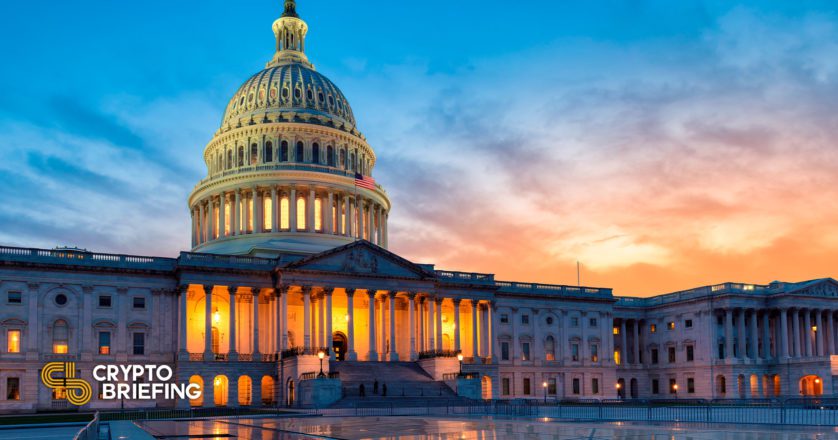Could the New House Stablecoin Bill Kill FRAX and DAI?
The first draft of the new House Stablecoin Bill suggests placing a two-year ban on “endogenously collateralized stablecoins.”

Key Takeaways
- U.S. lawmakers are reportedly drafting a bill to place a two-year ban on certain stablecoins.
- The House Stablecoin Bill would target “endogenously collateralized stablecoins.”
- The new bill could impact decentralized stablecoins like FRAX, depending on the wording used in the final draft.
Share this article
The legislation comes in response to the May collapse of the algorithmically-backed TerraUSD stablecoin.
U.S. Proposes Stablecoin Regulation
House lawmakers are taking a step toward regulating stablecoins.
A new bill is seeking to place a two-year ban on “endogenously collateralized stablecoins,” according to a draft obtained by Bloomberg late Tuesday.
The House Stablecoin Bill would make it illegal to issue or create new stablecoins that mimic the functionality and features of TerraUSD—an algorithmically-backed stablecoin that infamously lost its dollar peg in May, wiping out billions of dollars in value as it irrecoverably crashed to zero. More specifically, the bill would prohibit any stablecoin marketed as being able to be converted, redeemed, or repurchased for a fixed amount of monetary value, as well as any that relies solely on the value of another digital asset from the same creator to maintain a fixed price.
In addition to the moratorium on algorithmically-backed stablecoins, the bill draft also mandates a study on Terra-like tokens from the Treasury in consultation with the Federal Reserve, the Office of the Comptroller of the Currency (OCC), the Federal Deposit Insurance Corp., and the Securities and Exchange Commission.
While the bill primarily focuses on restricting “unbacked” stablecoins from entering circulation to protect consumers, it also contains guidance on how fiat-pegged assets should be regulated more generally. The bill would allow both banks and non-banks to issue stablecoins. However, bank issuers would need approval from federal regulators such as the OCC. As for non-bank issuers, the legislation directs the Federal Reserve to establish a process for making application decisions.
The House Stablecoin Bill is the first piece of legislation directed at regulating the burgeoning stablecoin market. According to data from CoinGecko, the total stablecoin market capitalization sits at over $153 billion. The market size has increased by around 600% as the broader crypto ecosystem has grown over the past two years.
While the bulk of stablecoins in circulation are backed by dollar or dollar equivalents, many dollar-pegged tokens use novel methods to maintain their value. Although the bill is still being drafted, many crypto users are worried that its wording may implicate several legitimate stablecoin projects in its two-year ban.
Which Stablecoins Could Be Affected?
Although the bill draft’s wording is still subject to change, the current version gives some clues as to the direction regulators intend to take. The phrase “endogenously collateralized stablecoins” is broad and may refer to any token backed or partially backed by other tokens from the same issuer.
TerraUSD, which was solely collateralized by Terra’s native token LUNA, would almost certainly face a two-year ban if it were still functioning today. However, for protocols creating dollar-pegged assets using a mixture of tokens that are both endogenous (created by the same issuer) and exogenous (issued by other parties), the bill is less clear.
On the one hand, previous failed stablecoin projects such as Iron Finance do not necessarily fit the definition of being solely collateralized by endogenous tokens. The protocol used an initial ratio of 75% USDC and 25% TITAN tokens to mint its IRON stablecoin. However, as history proved, when IRON crashed to zero in June 2021, this kind of collateralization method still poses a substantial risk to investors.
Other protocols such as Frax Finance have so far successfully utilized a mixed collateralization method. Frax, an abbreviation of “fractional-algorithmic,” uses a variable ratio of USDC and its free-floating Frax Shares token to mint and collateralize its dollar-pegged FRAX. This method of collateralization appears much more resilient than previous projects such as TerraUSD or Iron Finance. However, whether the new stablecoin bill will recognize this difference remains to be seen.
Another concern regarding the new bill is how it might affect MakerDAO’s DAI stablecoin. Unlike IRON and FRAX, DAI is completely collateralized by exogenous assets, primarily USDC and ETH. Because of this, the bill’s ban shouldn’t implicate DAI. However, like all other non-bank stablecoin issuers, if the new bill is passed into law, the Maker protocol will likely need to register with U.S. regulators to continue serving users in the U.S.
As the U.S. government’s first foray into stablecoin legislation, the bill draft appears fairly conservative. In line with Treasury Secretary Janet Yellen’s previous comments, regulators are looking to stablecoin issuers more in line with traditional finance. For most stablecoin issuers, this shouldn’t be a problem. However, as always, the devil is in the details, so the bill’s final version will need to be released before its potential impact becomes clear.
Disclosure: At the time of writing this piece, the author owned ETH and several other cryptocurrencies.
Share this article
